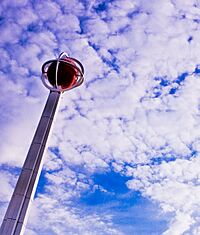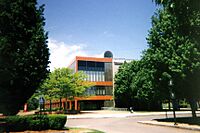Naismith Memorial Basketball Hall of Fame facts for kids

The Hall of Fame in 2010
|
|
| Established | 1959 (organization) February 17, 1968 (facility) |
|---|---|
| Location | Springfield, Massachusetts |
| Type | Professional sports hall of fame |
The Naismith Memorial Basketball Hall of Fame is an American history museum and hall of fame, located at 1000 Hall of Fame Avenue in Springfield, Massachusetts. It serves as basketball's most complete library, in addition to promoting and preserving the history of basketball. Dedicated to Canadian-American physician James Naismith, who invented the sport in Springfield, the Hall of Fame inducted its first class in 1959, before opening its first facility on February 17, 1968.
As of the Class of 2022, the Hall has formally inducted 436 players, coaches, referees, and other basketball professionals. The Boston Celtics have the most inductees, with 40.
History of the Springfield building
The Naismith Memorial Basketball Hall of Fame was established in 1959, without a physical location, by Lee Williams, a former athletic director at Colby College. In the 1960s, the Hall of Fame struggled to raise enough money to construct its first facility. However, the necessary amount was raised, and the building opened on February 17, 1968, less than a month after the National Basketball Association played its 18th All-Star Game. The Basketball Hall of Fame's Board named four inductees in its first year. In addition to honoring those who contributed to basketball, the Hall of Fame sought to make contributions of its own. In 1979, the Hall of Fame sponsored the Tip-Off Classic, a pre-season college basketball exhibition. The Tip-Off Classic has been the start to the college basketball season ever since, and although it does not always take place in Springfield, Massachusetts, generally it returns every few years.
In the 17 years that the original Basketball Hall of Fame operated at Springfield College, it drew over 630,000 visitors. The popularity of the Basketball Hall of Fame necessitated a new facility, and on June 30, 1985, an $11.5 million facility was opened beside the Connecticut River in Springfield. As the new hall opened, it also recognized women for the first time, with inductees such as Senda Berenson Abbott, who first introduced basketball to women at Smith College. During the years following its construction, the Basketball Hall of Fame's second facility drew far more visitors than anticipated, due in large part to the increasing popularity of the game but also to the scenic location beside the river and the second Hall's interesting modern architecture.
In 2002, the Basketball Hall of Fame moved again—albeit merely 100 yards south along Springfield's riverfront—into a $47 million facility designed by Gwathmey Siegel & Associates. The building's architecture features a metallic silver, basketball-shaped sphere flanked by two similarly symmetrical rhombuses. The dome is illuminated at night and features 80,000 square foot (7,400 m2), including a Subway sandwich shop, and an extensive gift shop. The second Basketball Hall of Fame was not torn down, but was converted into an LA Fitness health club. The Basketball Hall of Fame features Center Court, a full-sized basketball court on which visitors can play. Inside the building there are a game gallery, many interactive exhibits, several theaters, and an honor ring of inductees. A large theater for ceremonies seats up to 300. The honorees inducted in 2002, included the Harlem Globetrotters and Magic Johnson, a five-time NBA champion, three-time NBA finals MVP and Olympic gold medalist.
As of 2011, the Basketball Hall of Fame has greatly exceeded attendance expectations, with basketball fans traveling there from all over the world.

Criteria for induction
In contrast to the Soccer and the National Baseball Halls of Fame, Springfield honors international and American professionals, as well as American and international amateurs, making it arguably the most comprehensive Hall of Fame among major American sports. From 2011 to 2015, seven committees were, and as of 2016, six committees are employed to both screen and elect candidates. Four of the committees screen prospective candidates:
- North American Screening Committee (9 members)
- Women's Screening Committee (7 members)
- International Screening Committee (7 members)
- Veterans Screening Committee (7 members), with "Veterans" defined as individuals whose careers ended at least 35 years before they are considered for election.
Since 2011, the Veterans and International Committees also vote to directly induct one candidate for each induction class.
Three committees were formed in 2011 to directly elect one candidate for each induction class:
- American Basketball Association Committee – This committee was permanently disbanded in 2015, because it had fulfilled its purpose over the previous five years.
- Contributor Direct Election Committee
- Other committees may choose to elect contributors. For example, the 2014 class included two contributors.
- Early African-American Pioneers of the Game Committee
Individuals who receive at least seven votes from the North American Screening Committee or five votes from one of the other screening committees in a given year are eligible to advance to an Honors Committee, composed of 12 members plus rotating groups of 12 specialists (one group for female candidates, one group for international candidates, and one group for American and veterans candidates) who vote on each candidate. Each screening committee has a limited number of candidates it may submit to the Honors Committee—10 from the North American Committee, and two from each of the other committees. Any individual receiving at least 18 affirmative votes (75% of all votes cast) from the Honors Committee is approved for induction into the Hall of Fame. As long as the number of candidates receiving sufficient votes from a screening committee is not greater than the number of finalists that the committee is permitted to submit, advancement to the Honors Committee is generally pro forma, although the Hall's Board of Trustees may remove from consideration any candidate who "has damaged the integrity of the game of basketball".
To be considered for induction by a screening committee, a player, retired coach, or referee must be fully retired from that role for at least three full seasons. The waiting period had originally been five years, but was changed to four years in December 2015, and to three seasons in December 2017. Prior to the induction class of 2018, referees had been eligible for induction after 25 years of full-time service, even if still active. Changes to the criteria for consideration of active coaches were also announced as part of the 2017 changes. Coaches become eligible upon 25 years of full-time service at the high school level or above, or three seasons after retirement. Effective with the class of 2020, active coaches must meet the years of service requirement and be at least 60 years old. No years of service criterion is required for those who have made a "significant contribution to the game of basketball". Sportswriters and commentators can be elected as full-fledged members, in contrast to the Baseball Hall of Fame that places them in separate wings from the "real" Hall of Fame.
Inductees

Since 1959, 436 coaches, players, referees, contributors, and teams have been inducted, with the most recent class entering on September 9, 2022. John Wooden, Lenny Wilkens, Bill Sharman, Tom Heinsohn, and Bill Russell have each been inducted as both player and coach (Wooden in 1960 and 1973, Sharman in 1976 and 2004, Wilkens in 1989, 1998 and 2010, Heinsohn in 1986 and 2015, and Russell in 1975 and 2021). John McLendon has been inducted as both coach and contributor, entering in 1979 as a contributor and 2016 as a coach.
On three occasions, the Hall has inducted new classes without honoring a player – 1965, 1968, and 2007.
Other awards
In conjunction with the Final Four of each year's NCAA Division I men's and women's basketball tournaments, the Naismith Hall gives out several awards to college basketball athletes:
For men, the Hall presents awards to the top players in Division I at each of the five standard basketball positions.
- The Bob Cousy Award, presented since 2004 to the top point guard. The award was originally open to players in all three NCAA divisions (I, II, and III), but then restricted to D-I players.
- The Jerry West Award, presented since 2015 to the top shooting guard.
- The Julius Erving Award, presented since 2015 to the top small forward.
- The Karl Malone Award, presented since 2015 to the top power forward.
- The Kareem Abdul-Jabbar Award, presented since 2015 to the top center.
Each of the award winners is chosen by a Hall of Fame selection committee, plus the award's namesake.
The Hall, in cooperation with the Women's Basketball Coaches Association, presents analogous awards for the top Division I women's players at each position. One has been awarded since 2000; the others were first presented in 2018.
- The Nancy Lieberman Award for the top point guard was the Hall's only women's positional award that was presented before 2018, having first been awarded in 2000.
- The Ann Meyers Drysdale Award, first presented in 2018 to the top shooting guard.
- The Cheryl Miller Award, first presented in 2018 to the top small forward.
- The Katrina McClain Award, first presented in 2018 to the top power forward.
- The Lisa Leslie Award, first presented in 2018 to the top center.
As with the men's awards, the selection committee for the women's awards includes each award's namesake.
The Hall also formerly presented the Frances Pomeroy Naismith Award to two college seniors—one male player no taller than 72 inches (1.83 m), and one female player no taller than 68 inches (1.73 m)—determined to have been the nation's best student-athletes. The men's award, given since 1969, was voted on by the National Association of Basketball Coaches (NABC), and the women's, given since 1984, by members of the Women's Basketball Coaches Association. Both awards were discontinued after the 2012–13 season.
See also
 In Spanish: Salón de la Fama del Baloncesto para niños
In Spanish: Salón de la Fama del Baloncesto para niños
- Award share
- EuroLeague Legend
- FIBA Hall of Fame
- List of members of the FIBA Hall of Fame
- List of members of the Naismith Memorial Basketball Hall of Fame
- List of coaches in the Naismith Memorial Basketball Hall of Fame
- List of players in the Naismith Memorial Basketball Hall of Fame
- National Collegiate Basketball Hall of Fame
- Women's Basketball Hall of Fame

